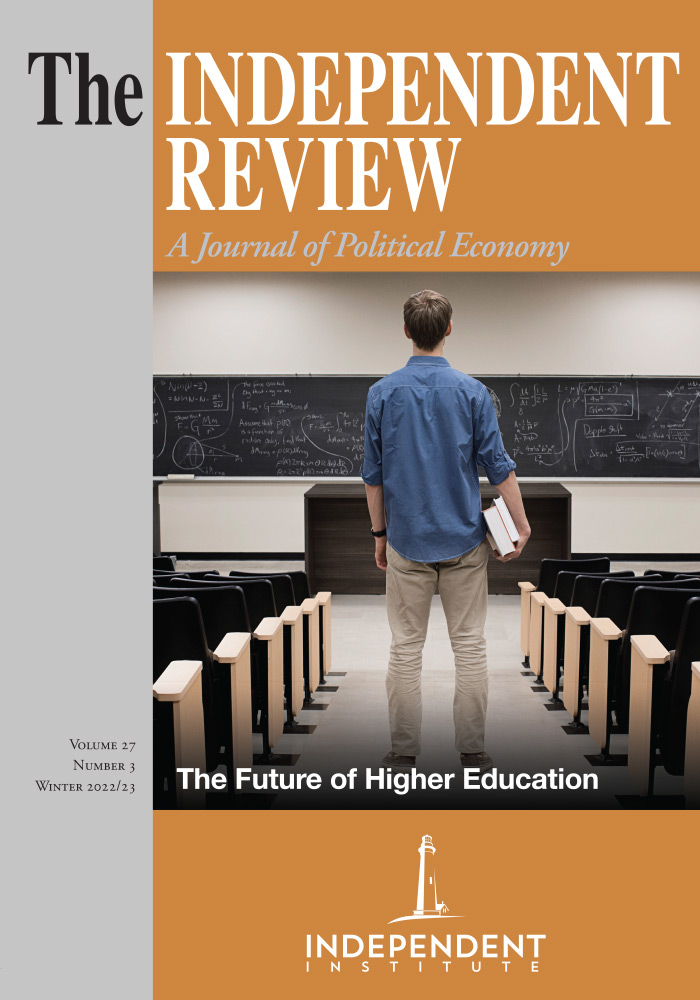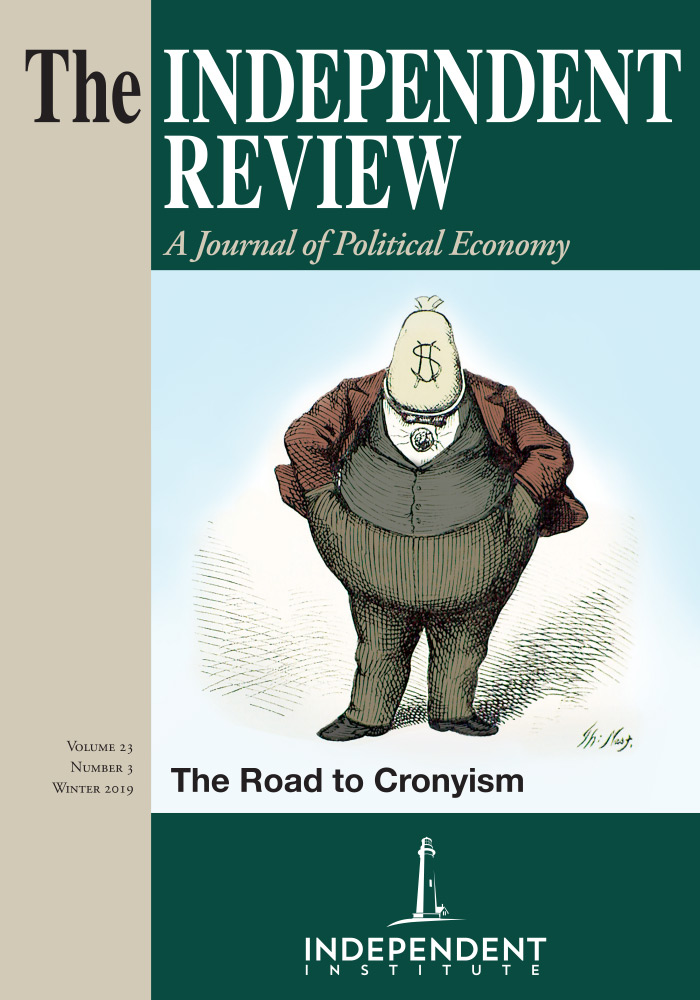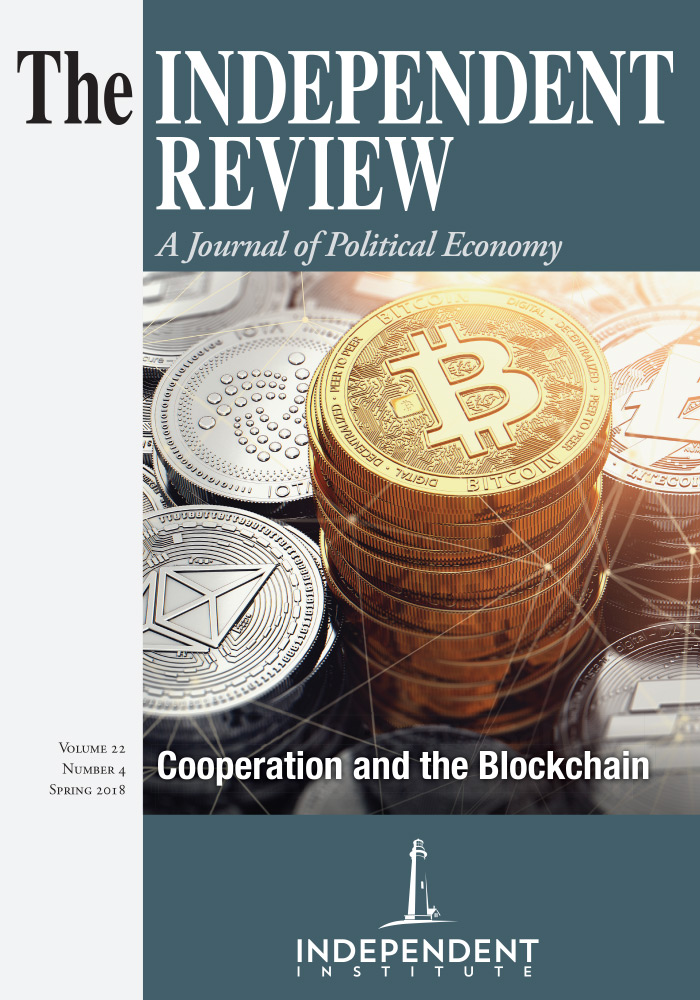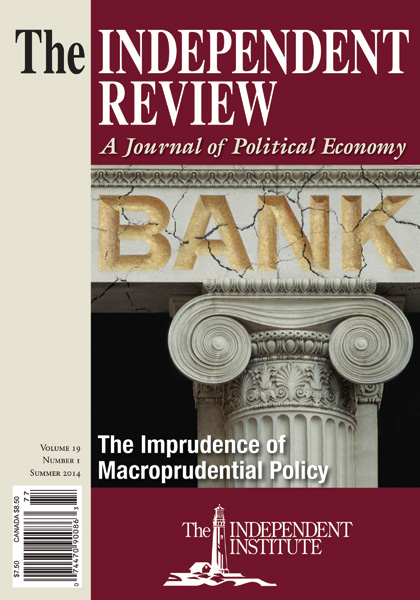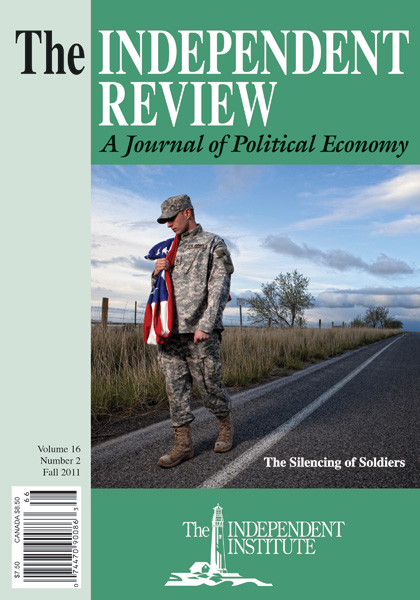Over the span of many years, Senator Elizabeth Warren’s books have shifted in content and tone from thoughtful and well-researched to rhetorical and boilerplate. Also notable is that her faith in government coexists with her profound and wide-ranging pessimism about how government works in practice.
Article
When one of my sons does something unexpected, I like to joke: “Who are you, and what have you done with my son?” After reading Elizabeth Warren’s three books on politics, I had the same question about her.
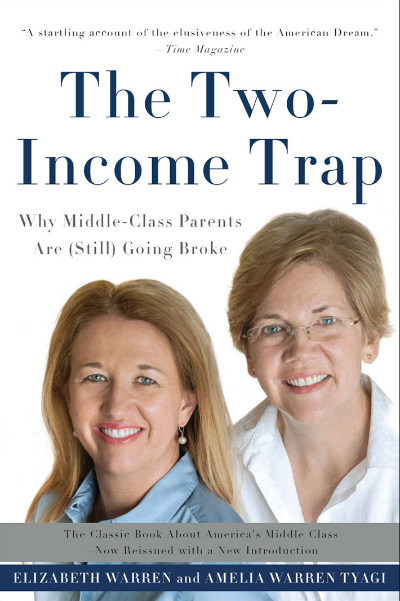 Warren has had a prolific writing career, including many journal articles and
academic books on her most relevant research interests in bankruptcy law and personal
finance. Her first overtly political book, The Two-Income Trap: Why Middle-Class
Mothers and Fathers Are Going Broke (New York: Perseus, 2003), coauthored with
her daughter, Amelia Warren Tyagi, is moderate politically and even conservative
socially. Beyond that, some of her arguments on public-policy consequences are so well
reasoned that it brings a tear to an economist’s eye. But, really, the book seems like the
sort of thing you’d expect from an academic—thorough work, thoughtful analysis, and
careful conclusions.
Warren has had a prolific writing career, including many journal articles and
academic books on her most relevant research interests in bankruptcy law and personal
finance. Her first overtly political book, The Two-Income Trap: Why Middle-Class
Mothers and Fathers Are Going Broke (New York: Perseus, 2003), coauthored with
her daughter, Amelia Warren Tyagi, is moderate politically and even conservative
socially. Beyond that, some of her arguments on public-policy consequences are so well
reasoned that it brings a tear to an economist’s eye. But, really, the book seems like the
sort of thing you’d expect from an academic—thorough work, thoughtful analysis, and
careful conclusions.
With her newfound influence and fame, Warren became a politician—a senator and now a candidate for president. That’s not necessarily a problem. One would hope that she would bring the best of her academic background to her new career. Unfortunately, she has turned over a new leaf. The second and third books are a combination of biography and political rhetoric—with notably little of the impressive analysis she displayed in the first book. And her political career can be summarized as a stunning example of hypocrisy against her first book that I share toward the end of this essay.
Murphy’s Law, “Playing by the Rules,” and Financial Woes
Warren’s thesis in The Two-Income Trap (TT) is that when financial troubles come, life often falls apart for average people who “play by the rules.” If they don’t have enough money saved, they may not have the margin to get through the difficulty. They can’t make payments; they borrow money; and they dig a hole that often ends up in bankruptcy.
If people live responsibly, then we hope that such occasions are rare and anecdotal rather than all too common and part of a trend. Of course, one can reasonably quibble with Warren by noting that a refusal to save enough money to deal with common problems is not exactly living responsibly or “playing by the rules” of the game of life—as life really works.
Warren’s concerns, interests, and questions follow naturally from her research and her assessment of the problems: Can the catalysts for financial trouble be mitigated through public policy? Should we use policy to restrict those who lend money to people, especially people in distress? And how can we encourage people to handle their personal finances more effectively?
If people are struggling with debt, it can only be an income or spending problem. Household incomes are generally higher, so there must be more spending, too. The title of the relevant chapter is “The Over-consumption Myth.” But the “myth” is true, by definition. People in debt have necessarily overconsumed—spent more than they have. What she really means is that the spending is not “frivolous.” (In a later chapter, Warren provides evidence that the problem is not a greater reluctance to pay one’s bills—a drop in morality that might lead people to renege on debts.)
Warren presents data on changes in spending over time and reports that the bulk of the increased spending comes from housing. Houses are not much fancier, but they are bigger. That said, a larger issue is what Warren rightly (and impressively) sees as the connection between housing values, school quality, and neighborhood safety (TT, pp. 25, 28). This leads her to advocate greatly expanded school choice—vouchers, charters, and so on—to break the link between housing and schools.
More spending and more income could leave budgets in the same place, on net. But Warren notes the growing prevalence of two working parents. And if trouble comes—for example, from job loss or health problems or both—families have less flexibility to fix their income or adjust their spending. (Warren’s parents used this approach when her father struggled with health issues and the job market, and her mother slid into the workforce to help out.)
One of the ironies with housing is that it is not a frivolous cost. And as a fixed cost in one’s budget, it creates much more strain if household income is compromised. Housing is often sold as a responsible purchase, an investment, a middle-class ideal. But with income troubles, the monthly cost of housing can be an albatross to a strained budget.
Warren also notes other concerns. The problems increase with the instabilities of divorce and cohabitation—both of which have become far more prevalent. If two parents are working, it’s at least twice as likely that one will lose a job. And if labor markets have more “churn” than in past decades, the likelihood of trouble increases further. As such, Warren laments the “two-income trap” of both parents working. She’s careful to say that this lament is not opposition to women working per se. But the implication is that the second spouse working—usually the woman—does create much of the problem at hand. (On women entering the labor force, Warren critiques the Left and the Right—the Left for assuming that it is all benefit and no cost; the Right for underestimating the value of women at home [TT, p. 67].)
 So Warren makes a compelling case that our approach to life has changed, creating
more potential for budget troubles. One implication is the need for a different, moredisciplined
approach to personal finance—something that gets a full chapter in The Two-Income Trap and a separate (nonpolitical) book from her on the topic: All Your Worth:
The Ultimate Lifetime Money Plan, with Amelia Warren Tyagi (New York: Simon and
Schuster, 2005). As an aside, it’s probably worth noting that these increasing woes with
personal finance have led to the popularity of Dave Ramsey and other gurus who have
stepped into this vacuum to help people handle their personal finances more wisely.
So Warren makes a compelling case that our approach to life has changed, creating
more potential for budget troubles. One implication is the need for a different, moredisciplined
approach to personal finance—something that gets a full chapter in The Two-Income Trap and a separate (nonpolitical) book from her on the topic: All Your Worth:
The Ultimate Lifetime Money Plan, with Amelia Warren Tyagi (New York: Simon and
Schuster, 2005). As an aside, it’s probably worth noting that these increasing woes with
personal finance have led to the popularity of Dave Ramsey and other gurus who have
stepped into this vacuum to help people handle their personal finances more wisely.
Warren’s Policy Prescriptions in 2003
In terms of policy, Warren’s prescriptions in The Two-Income Trap are moderate and rather mild—especially when compared with her later two books and her proposals as a candidate for president. This policy modesty stemmed from her relatively impressive understanding of how markets work.
In trying to address higher housing prices, Warren critiques a “usual liberal approach” such as price ceilings: “We don’t think the solution lies with such complex regulations. Indeed, any effort to eliminate the fundamental forces of supply and demand with such artificial constraints might actually worsen the situation by diminishing the incentive to build new houses or improve older ones” (TT, p. 33). Sounds like a candidate to teach “Principles of Microeconomics”!
Warren continues: “Nor would we argue for outright government subsidies. . . . America simply cannot afford mass subsidies for its middle class to buy housing. Besides, direct subsidies are likely to add more ammunition to the already ruinous bidding wars, ultimately driving home prices even higher” (TT, p. 33). She clearly understands how subsidies distort markets and inflate prices.
Warren argues instead that we should change how schools are funded. “In order to free families from [the two-income] trap, it is necessary to go to the heart of the problem: public education. Bad schools impose indirect—but huge—costs on millions of middle-class families. . . . The only way to take pressure off these families is to change the schools” (TT, p. 33). From there, she advocates vouchers so that “tax dollars would follow the children”; she notes the need to have larger vouchers for those with disabilities; and she wants to extend this approach into preschool (TT, pp. 35, 121).
Warren notes the claim that vouchers “drain off” funds but argues against it: “[T]he public-versus-private competition misses the central point. The problem is not vouchers; the problem is [a lack of] parental choice” (TT, p. 34). She acknowledges that “an all-voucher system would be a shock to the educational system, but the shakeout might be just what the system needs” (TT, p. 36). She respects the central role of choice and competition to well-functioning markets for the benefit of consumers and society.
Warren makes similar arguments to critique subsidies for day care proposed by some on the left. “It is time for a hard look at this sacred cow. How much help would subsidized day care really offer to middle-class families? . . . The long-term financial implications aremore complex. . . . [N]o help for familieswith a stay-at-homemother . . . create[s] yet another comparative disadvantage for single-income families trying to compete in the marketplace. . . . In effect, government-subsidized daycare would add one more indirect pressure on others to join the workforce” (TT, pp. 39–40). Again, she exhibits a sophisticated understanding of why subsidies cause so much damage.
Warren’s prescriptions are not universally impressive, though, and her understanding of markets is not always so sharp. She advocates subsidized child care for single parents (TT, pp. 122), despite the inherent incentive problems that would likely increase the prevalence of single parenthood. She complains about inflation in higher education (TT, p. 45), but she relies on “sticker price” (rather than tuition paid)—a common error. She sees an increase in demand for college but imagines that supply is somehow fixed, leading to higher prices. And although she is clearly aware of the impact of subsidies in other areas, she doesn’t seem to see it here. (Or maybe she doesn’t mind subsidies in her own industry!)
More debatable but still reasonable: Warren advocates reform and expansion of federal long-term disability insurance (TT, p. 92–94). She also advocates subsidies for all middle-class savings, phasing out with higher incomes (TT, pp. 69–70). She doesn’t address sales taxes of various sorts, which would accomplish similar goals. But, to be fair, the better versions of “fair-tax” legislation were not available until after her first book was published.
Warren also doesn’t understand the level of competition in banking—or the connections between risk and rate of return (TT, pp. 129, 146, 148). If borrowers seem to present more risk, lenders will (reasonably) charge them higher rates. Moreover, she doesn’t seem to catch the role of the government in distorting financial markets and causing trouble for consumers and taxpayers—whether Fannie Mae in general (TT, pp. 133, 159) or efforts to sell homes to disadvantaged minority groups in particular (TT, p. 136).
Finally, Warren’s level of trust toward consumers, in particular the poor and certain minority groups, is not very high. “They didn’t know they could do any better” (TT, p. 135). The market “hits minority homeowners with particular force,” especially African Americans and Hispanics (TT, pp. 136, 146, 147, 159). And she doesn’t see—or doesn’t mind—the reduction in lending for homes and credit to the same minority groups that would be caused by her proposed regulations (TT, pp. 147, 149).
Warren, Politics, and “the Fight”
 Unfortunately, most of the impressive things about Warren went out the proverbial
window when she became a politician. It’s easy to see when you compare The Two-Income
Trap to her other two political books: A Fighting Chance (FC) (New York: Holt, 2014)
and This Fight Is Our Fight: The Battle to Save America’s Middle Class (FF) (New York:
Holt, 2017). The two later books are as different from the first as they are similar to each
other. Fighting Chance is more biography, and This Fight is more about policy advocacy.
Unfortunately, most of the impressive things about Warren went out the proverbial
window when she became a politician. It’s easy to see when you compare The Two-Income
Trap to her other two political books: A Fighting Chance (FC) (New York: Holt, 2014)
and This Fight Is Our Fight: The Battle to Save America’s Middle Class (FF) (New York:
Holt, 2017). The two later books are as different from the first as they are similar to each
other. Fighting Chance is more biography, and This Fight is more about policy advocacy.
 Warren’s biographical information has always ranged from common (her
Oklahoma, lower-middle-class roots) to elite (a lawyer teaching at Harvard) to
famously strange (claiming a Native American “background” [FC, pp. 239–40] and
“ancestry” [FF, p. 224]). And there has been controversy about her claim that she
was fired after getting pregnant. “The principal did what I think a lot of principals did
back then—wished me good luck, didn’t ask me back for the next school year, and
hired someone else for the job” (FC, p. 14).
Warren’s biographical information has always ranged from common (her
Oklahoma, lower-middle-class roots) to elite (a lawyer teaching at Harvard) to
famously strange (claiming a Native American “background” [FC, pp. 239–40] and
“ancestry” [FF, p. 224]). And there has been controversy about her claim that she
was fired after getting pregnant. “The principal did what I think a lot of principals did
back then—wished me good luck, didn’t ask me back for the next school year, and
hired someone else for the job” (FC, p. 14).
Both of the recent books move toward rhetoric and boilerplate. Her posturing and rhetoric are probably par for an unfortunate course in politics. In both books, “[t]he game is rigged” is a favored phrase for how to think about government (FC, pp. 2, 3; FF, p. 59). She wants corporations and the wealthy “to pay a little more” (FC, p. 215). She claims to be worried about loopholes but has only criticism for the tax reforms of the 1980s (FF, pp. 114, 116). She describes the Koch brothers as “ultraconservative” rather than libertarian (FF, pp. 161–62).
Warren gets particularly exorcised in the more recent book when talking about President Donald Trump. She asserts that the election of Trump would “deliver one more body blow to so many working families. . . . [L]ife [is] about to get a whole lot tougher” (FF, p. 3). The “middle class was already on its knees. . . . Trump could be the punch that knocked out everyone’s lights and changed our country forever. . . . Trump seemed determined to crush the last vestiges of hope” (FF, p. 215). Warren’s hyperbole is strange for an academic and disturbing for a politician.
Warren’s New Policy Positions
Posturing is a problem, but policy is more important. Both of the recent books move far away from careful analysis, ignoring the economic cause and effect she identifies so ably in her first book. And her policy prescriptions have flipped, evolved, and grown appendages. New policy preferences have emerged that seem unrelated to her expertise, her previous views, or anything aside from what looks like a crass grab for political power. She now emphasizes spending on infrastructure and research and is a fan of unions (FC, p. 2; FF, pp. 102, 104). And a higher minimum wage is somehow the first policy she discusses in her crusade “to save America’s middle class” (FF, pp. 7–10).
Other policy positions have evolved or flipped—without analysis or explanation for the changed views. In education, she had formerly emphasized “school choice” and local/state funding. But now there’s no mention of choice, and her funding ideas are centralized and federal (FF, pp. 4, 100). She applauds the GI Bill’s vouchers for college, but her avid support for K–12 vouchers has disappeared (FF, p. 100). She opposed broad subsidies but now wants vast subsidies for college—past, present, and future (FC, p. 2; FF, p. 100).
The flips go beyond education. She now advocates subsidies for child care. She complains about food stamps as a subsidy to Walmart—ripping Walmart instead of the subsidies (FF, pp. 24–25). She understood the problems with price ceilings on housing but then misses that the Affordable Care Act caused trouble with “low wages and unpredictable schedules” (FF, p. 28). And her sense of cause and effect has changed: from women voluntarily joining the workforce out of newfound cultural freedom and economic opportunity to the coercion of “growing financial pressure [to send] everyone to work” (FF, pp. 30–31).
To her credit, Warren lays out an implicit critique of President Barack Obama’s economic record (FF, p. 17). She doesn’t mention his historically tepid economic recovery, but she doesn’t embrace the common Democrat hypocrisy of lauding Obama’s strong stock market with his rough economy—a record that would have been roundly criticized by the same folks if the president had been Republican.
Given Warren’s research on consumer debt and “predatory finance,” one can discern an evolution toward populism, distrust of corporations, concern about market outcomes, and faith in government solutions—all in that same arena. One can recognize how she has too little cynicism about government regulation, given her exaggerated sense of its benefits and a diminished sense of its costs.
Warren cites Franklin Roosevelt’s efforts to pass “laws to make the economy safer” (FF, p. 68). She imagines him as an antitrust maven, artificially elevating the value of regulation (FF, p. 71). She complains about market consolidation, while missing the necessary impact of greater regulations on economies of scale and greater market concentration (FF, p. 88). She also misses the greater competition today because of greatly reduced transaction costs.
Given her simplistic and erroneous views on macroeconomics and macroeconomic history, one can understand how Warren could be too optimistic about government activism. She claims that investments in research have an “immediate” multiplier of 2.2 on the economy (FF, p. 132). So, of course, more government spending there would be a glorious thing (FF, p. 82)! Warren seems unaware of the trouble caused by the Fed’s inflation from the 1960s into the early 1980s—for the economy in general and for “savings and loans” in particular.
Warren’s views on the Great Depression are even worse. She applauds FDR’s policy experimentation, although the results of the New Deal were lousy, and the experiments served to increase uncertainty in already-fragile markets (FF, p. 67). She argues that the government passed “strong laws” during the Great Depression to help consumers and producers, without explaining how wage-and-price floors could possibly serve both of those masters (FF, p. 72). She conveniently skips through the length of FDR’s Great Depression to reach World War II as the solution (FF, p. 74). (See Amity Shlaes, The Forgotten Man: A New History of the Great Depression [New York: Harper Collins, 2007], for critiques of these claims.)
Warren sums up her view of macroeconomic activism and government regulation with a simple graph (FF, p. 92)—showing how everything was peaches and cream between the Great Depression of 1929 and the Great Recession of 2007, both of which were supposedly caused by “deregulation.”
Warren concludes: “I’m a deeply pro-market person. I believe that competition delivers great value for American consumers. That’s why I also believe in enough regulations to keep those markets honest” (FF, p. 149). The good news: Warren is “promarket” rather than the “pro-business” of crony capitalism. But she ends up in elitism and a strain of progressivism, advocating heavy doses of regulation because she “believes” in competition but not companies or consumers.
She offers reasonable stories for some of her policy evolution, I suppose. But none of them explain her newfound, broad excitement about government subsidies—in the face of the impressive understanding she exhibited in The Two-Income Trap. Beyond grand plans that can’t possibly be financed through wealth and income taxes, her recent and avid embrace of wide-ranging and extensive subsidies—for college, student-loan forgiveness, child care, and health care—makes no sense and has no apparent cause.
Why Does Warren Have so Much Faith in Government?
The other strange thing about Warren is that her faith in government coexists with her profound and wide-ranging pessimism about how government works in practice. In all of her books, she frequently complains about how government functions—whether through cronyism or ineptitude from politicians and bureaucrats to expert witnesses, lobbyists, and lawyers. At the end of the day, this combination of faith and skepticism may be the most difficult thing to reconcile about her views because she repeatedly provides compelling reasons why she (and we) should not trust government.
She worries about a new financial bureaucracy being run by Tim Geithner, someone she sees as a political hack (FC, p. 185). She notes that a small mistake in writing successful legislation led to huge problems (FC, p. 175). She complains about the government making huge profits in student loans (FF, pp. 121–27). She informs readers about “cromnibus”—the combination of “continuing resolutions” and giant “omnibus” spending bills that Congress uses to inefficiently fund government spending (FF, p. 152). And she critiques expert witnesses in lobbying (FF, p. 193). That said, Warren nevertheless seems comfortable knowing which experts she can trust—for example, on climate change (FF, p. 199)!
In a word, she’s well aware of the perils of government—from incompetence to crony capitalism. But she also believes that she can harness government to her liking and doesn’t trust the market left to its own devices. Peter Suderman probably understands her political philosophy best: “The economy is fundamentally fixable—but only if Elizabeth Warren is manipulating all the levels of power” (“Elizabeth Warren’s Plans Don’t Add Up,” Reason, October 2019).
On Political Animals
So here’s the most amazing story in Warren’s books. She cut her teeth in academics, advocacy, politics, and second-tier fame through her work in bankruptcy law. And for what might seem like a dry topic, the narrative is a relatively compelling read: the research findings, the policy implications, invitations to meet with powerful people and to testify in front of Congress, the opposing lobbyists and various political machinations.
The highlight is Warren’s opportunity to meet with First Lady Hillary Clinton. Warren and her colleagues had come up with a “good” bankruptcy bill, but it had been supplanted by a “bad” bill brought forward by industry lobbyists. Congress and President Bill Clinton supported the latter bill. But Warren got the opportunity to talk with Hillary in May 1998 after Hillary saw Warren’s op-ed in the New York Times.
Warren was really impressed by Hillary: “She ate fast and asked questions even faster. I have taught bankruptcy law to thousands of students—some of them among the brightest in the country—but I never saw one like Mrs. Clinton. Impatient, lightning-quick, interested in all the nuances” (TT, p. 124). And apparently open to reason: Warren persuaded Hillary, and then Hillary persuaded Bill to veto the bill when it finally got to his desk in October 2000.
That’s heady stuff and high drama—at least for a piece of legislation. But here’s the kicker: the “bad” bill was reintroduced in Congress the next spring. “This time, freshman Senator Hillary Clinton voted in favor of [that] bill. . . . The bill was essentially the same but Hillary Rodham Clinton was not. . . . Her husband was a lame duck at the time he vetoed the bill; he could afford to forgo future campaign contributions. As New York’s newest senator, however, it seems that Hillary Clinton could not afford such a principled position” (TT, pp. 125–26).
Warren isn’t done; she brings up the story again thirty pages later: “Senator Hillary Clinton bowed to big business. She had her chance to vote on what she had called that ‘awful bill.’ . . . Senator Clinton had taken $140,000 in campaign contributions from the banking industry, and she proved willing to overcome her ‘strong reservations’ about” the bill (TT, p. 156).
Eleven years later, Warren tells the story again in A Fighting Chance. This time, she shares Hillary’s role in persuading Bill to veto the bill but does not mention Hillary’s affirmative vote for the same bill in 2001 (FC, pp. 65–66). Of course, now that Warren is a senator, especially if she has even higher aspirations than she did in 2014, her redacted retelling is a smart political move. But her new narrative is also indicative of her emergence as a political animal.
We have seen her amazing flips on public policy: from one who knew better and opposed to someone who pretends not to know better and supports. The hypocrisy is stunning in any case, but especially because she crushed Hillary for the exact same move—and Warren’s own sins in this regard are far worse.
Fight the Power
One gets the sense that Bernie Sanders doesn’t know any better. He’s not thoughtful enough to understand how much he overstates government’s ability, disciplined enough to lay out the costs of his grand proposals, or self-reflective enough to catch the irony of his own capitalistic practices. But based on her first book, it is patently clear that ElizabethWarren does understand. And that’s probably more troubling. Ignorance with self-righteousness is one thing. Knowing better and then arguing otherwise is a different sort of evil.
So what happened to Warren? My best guess—and, I think, the most gracious interpretation of her hypocritical flips—is that “the fight” became everything. And so principles, wisdom, and insight became the casualties. The ends slowly began to justify the means. Maybe losing the “bankruptcy war” to Hillary and the lobbyists embittered her. Or maybe “subsidizing the wrong people”—through the Troubled Asset Relief Program and banks that were “too big to fail”—sent her over the edge. In any case, the cause made it acceptable to strive for power.
We must hope that Warren will not get to force her preferred version of society and her hypocrisies on others and that she will learn that there are things much more important than “the fight.” When the ends justify the means, it’s never ultimately good for those who misunderstand or those they try to influence and control.
| Other Independent Review articles by D. Eric Schansberg | ||
| Winter 2023/24 | Vivek Ramaswamy on What’s Troubling America | |
| Winter 2022/23 | Maverick: A Biography of Thomas Sowell | |
| Winter 2021/22 | The Meritocracy Trap: How America’s Foundational Myth Feeds Inequality, Dismantles the Middle Class, and Devours the Elite | |
| [View All (11)] | ||





